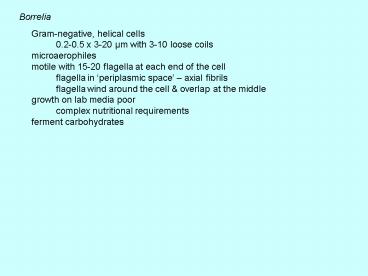Borrelia - PowerPoint PPT Presentation
1 / 20
Title:
Borrelia
Description:
lyme disease. Borrelia. relapsing fever. generalized infection; tick-borne ... lyme disease. three stages. 1st: fever, fatigue, headache, muscle/joint pain ... – PowerPoint PPT presentation
Number of Views:937
Avg rating:3.0/5.0
Title: Borrelia
1
Borrelia Gram-negative, helical
cells 0.2-0.5 x 3-20 µm with 3-10 loose coils
microaerophiles motile with 15-20 flagella
at each end of the cell flagella in periplasmic
space axial fibrils flagella wind around the
cell overlap at the middle growth on lab
media poor complex nutritional requirements
ferment carbohydrates
2
Borrelia antigens change rapidly
pathogens for birds and mammals vector
transmission lice scratching crushes
louse, releasing bacteria ticks bacteria
injected during bite classification based
on arthropod vector some names based on vector
species diseases relapsing fever lyme
disease
3
Borrelia relapsing fever generalized
infection tick-borne less severe fever,
headache, muscle pain lasts 4-10 days
followed by 5-6 asymptomatic days
relapse may cause myocarditis (mortality high)
mechanism of entry to blood unknown in
ticks cells become infected transovarian
passage occurs endemic disease and epidemic
disease
4
Borrelia lyme disease B. burgdorferi
Ixodes tick is vector
5
Borrelia lyme disease clinical feature
bullseye rash or erythema migrans
6
lyme disease three stages 1st fever,
fatigue, headache, muscle/joint pain 2nd
flu-like symptoms develop fever, chills,
stiffness neurological symptoms in 5-10 of
cases heart damage may occur in 5-10 of
cases 3rd joint inflammation arthritis-like
problems knee, elbow more serious
neurological problems may appear paralysis,
dementia
7
B. burgdorferi virulence factors surface
component binds integrins induces
IL-1ß lipoproteins elicit inflammatory
response (like LPS) cytokines TNF-a and
IL-1 released by macrophages flagellar antigens
similar to surface components of heart
and muscle cells surface antigens OspA and
OspB associated with chronic arthritis
8
B. burgdorferi role in arthritis TNF-a
IL-1ß are pro-inflammatory cytokines
IL-1ra is an anti-inflammatory cytokine balanced
role in rheumatoid arthritis high IL-1ra,
low IL-1ß rapid resolution of attacks
high IL-1ß, low IL-1ra long recovery after
attack
9
B. burgdorferi role of the immune system
IgG against bacterial surface components are
produced inhibit bacterial growth activate
complement-mediated killing IgG production
slow relative to other antigens maximum at 3-5
weeks levels double normal IgG levels
10
Treatment antibiotics are effective if
administered early Prevention reduce rodent
population wear protective clothing use
insecticide
11
Relapsing fever generalized
infection fever, headache, muscle pain due to
bacteremia lasts 4-10 days no symptoms for 5-6
days relapse transmitted by ticks or body
louse louse form epidemic relapsing fever B.
recurrentis tick form endemic relapsing
fever tick-borne less severe than
louse-borne relapses decrease in intensity
12
(No Transcript)
13
Relapsing fever bacteria in blood initiate
symptoms may cause myocarditis mortality
to 40 if untreated antibiotic therapy works
well
14
Gastric and duodenal ulcers ulcer treatment
long-term commitment, bland diet for
life expensive therapy - 10,000 per year
ulcer cause gastric acidity due to stress,
smoking, caffeine, etc. discovery of
bacterial cause good news how do bacteria
survive in acid in the stomach? about 10 of
cases not caused by bacteria NSAIDs and
autoimmune disease
15
Helicobacter pylori (Campylobacter pylori)
Gram-negative, long spirally curved rods 0.2-0.5
x 0.5-5 µm (can get to 8 µm) multi-layered
membrane (inside cell membrane) at ends
motile, single polar flagellum 2-3 times longer
than cell corkscrew-like motion
microaerophiles O2 levels at 3-15, CO2 levels
at 3-5 some may grow anaerobically oxidase-posi
tive metabolize TCA cycle intermediates,
amino acids sugars not metabolized present
in oral cavity, intestinal tract, reproductive
tract of man and animals
16
Helicobacter pylori (Campylobacter pylori)
several Campylobacter species are pathogens C.
fetus abortions in sheep, cattle C. jejuni
diarrhea can enter the blood C. pylori
isolated in the 1980s moved to Helicobacter
17
H. pylori virulence factors
adhesins bind molecules with terminal fucose
residue blood group O antigen bind
phosphatidylethanolamine bind sialic
acid-lactose residues bind laminin (in basement
membranes bind erythrocytes (hemagglutinin)
LPS causes inflammation cytotoxin causes
vacuoles to form in cells vacuoles
acidify cells die contribute to inflammation?
urease urea ? NH3 CO2 protects
bacteria in stomach
18
H. pylori infection source of organism
not clear to survive, organisms quickly
enter mucin use urease bacteria adhere to
mucosa produce ammonia LPS triggers
inflammatory response phagocytes, B cells
and T cells attracted cytotoxin aggravates
inflamed tissue heat-shock proteins induced
activates T cells
19
H. pylori infection inflammatory response
may clear bacteria if not 2nd stage two
outcomes 1. suppressor T cells
appear inflammatory response subsides
bacteria and host coexist bacteria persist
mucosal damage does not occur 2. suppressor T
cells cant control inflammation progressive
mucosal damage occurs inflammatory response
increases ulcer immunosuppression by T
cells may prevent ulcer formation
20
H. pylori infection early treatment two
antibiotics plus bismuth bismuth
anti-inflammatory reduces inflammation,
promotes healing antibiotics reduce bacterial
population currently two antibiotics, 12
weeks eradicates bacteria causes diarrhea
proposal mono- or disaccharides containing
fucose and/or sialic acid plus antibiotics































